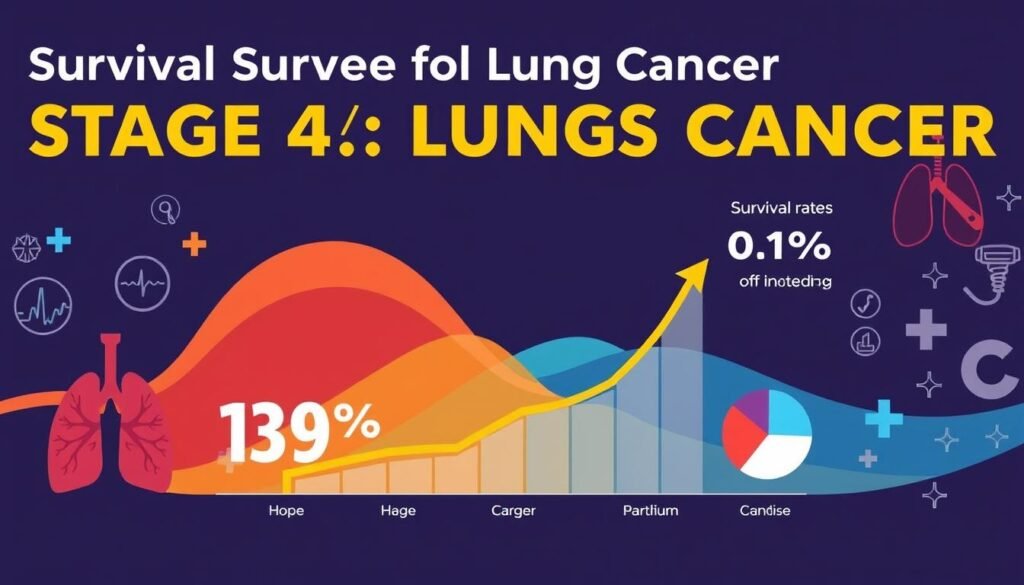Did you know that only about 15% to 19% of people diagnosed with stage 4 lung cancer live longer than a year? This fact shows how serious metastatic lung cancer is. It tells us why it’s important to know what to expect and what treatments can do. In stage 4, the cancer has spread from the lungs to other vital organs. Despite the low lung cancer survival statistics, there’s hope. New treatments are making a difference. Now, 19% of patients now survive the first year. It’s important for patients to get a thorough medical check-up and a treatment plan that’s just for them. This can help improve their lives.
For detailed info about stage 4 lung cancer survival rates, it’s key to stay updated. Patients should keep hope alive. It helps to work closely with doctors and support groups. They offer help and information on how to handle the treatment journey.
Key Takeaways
- Stage 4 lung cancer has a one-year survival rate between 15% and 19%.
- The five-year relative survival rate for non-small cell lung cancer is notably low at 9%.
- Recent advancements in treatment options are helping improve outcomes for patients diagnosed at this stage.
- Factors like overall health and specific lung cancer type can significantly influence prognosis.
- Patients are encouraged to seek personalized treatment plans for a better quality of life.
Understanding Stage 4 Lung Cancer
Stage 4 lung cancer is the most severe stage. It means the cancer has spread far from the lungs. This stage includes two types: non-small cell lung cancer (NSCLC) and small cell lung cancer (SCLC). Effective stage 4 lung cancer identification is about knowing when cancer moves to areas like the liver, brain, or adrenal glands.
NSCLC is more common and varies more in how it progresses. This leads to different treatment options and outlooks. SCLC, known as extensive stage, behaves like metastatic NSCLC, which makes treatment challenging.
Finding lung cancer early is hard. Many find out they have it when options are fewer. This delay affects survival rates. It makes managing symptoms and comfort very important.
| Type of Lung Cancer | Stage | Average Life Expectancy | Five-Year Survival Rate |
|---|---|---|---|
| Non-Small Cell Lung Cancer (NSCLC) | Stage 4 | 4-9 months | 7% |
| Small Cell Lung Cancer (SCLC) | Extensive Stage | 8-13 months | 3% |
Knowing the differences in lung cancer types is key for proper care. It helps doctors make the best treatment plans. It also helps patients know what to expect in their health journey.
Stage 4 Lung Cancer Survival Rates Overview
Stage 4 lung cancer has tough survival rates. It’s vital for patients and their families to understand these numbers. They need this knowledge to choose treatments wisely. Survival chances vary widely based on the lung cancer type.
General Survival Statistics
The numbers for stage 4 lung cancer survival can be scary. Studies show that 25% to 30% of patients might die within three months of being diagnosed. For those who survive this period, only 10% to 15% live much longer. This situation affects 70,000 to 105,000 people around the world every year.
The overall survival rates for stage 4 NSCLC are not very high:
- 1-year survival rate: 74%
- 2-year survival rate: 49%
- 5-year survival rate: 16%
- 10-year survival rate: 5%
These numbers show how serious a stage 4 diagnosis is. It stresses the need for early detection and effective treatment.
Comparative Survival Rates by Cancer Type
Looking at the survival rates, NSCLC and SCLC differ a lot. NSCLC’s five-year survival rate is around 8%. On the other hand, advanced SCLC has a survival rate of only 3%.
This difference highlights the prognosis challenges faced by patients. Below is a table showing these rates:
| Type of Lung Cancer | Stage | 5-Year Survival Rate |
|---|---|---|
| NSCLC | Stage IV | 2% – 13% |
| SCLC | Extensive Disease | ~1% |
Even though stage 4 lung cancer statistics seem grim, new treatments give hope. A person’s health, cancer type, and treatment response matter a lot.
Factors Influencing Survival Rates
It’s crucial to know what affects lung cancer prognosis. Survival rates for advanced lung cancer depend on many things. This includes the cancer type, the patient’s health, and specific genetic changes. Each of these factors plays a critical role.
Type of Lung Cancer: NSCLC vs. SCLC
Type of lung cancer majorly affects prognosis. Non-small cell lung cancer (NSCLC) usually has better survival rates than small cell lung cancer (SCLC). For instance, NSCLC’s five-year survival rate is about 24%. On the other hand, SCLC only has a survival rate of around 6%. Knowing these differences helps plan treatment and set expectations.
Impact of Overall Health on Prognosis
A patient’s overall health greatly affects their survival rates. Those with existing health problems, like lung or heart issues, are at a disadvantage. Patients who have lost more than 5% body weight before treatment also fare worse. Furthermore, a high performance status score means better survival chances.
This score shows the importance of being in good health. Patients in better shape can handle tough treatments or surgery better. This can lead to improved outcomes.
Genetic Mutations and Their Implications
Genetic mutations in lung cancer change how patients respond to treatment. Mutations, such as EGFR and ALK, may make targeted therapies work better. This can increase survival rates. Hence, knowing about these genetic changes helps choose the best treatment. It’s vital for personalizing care and improving prognosis.
Understanding lung cancer prognosis also involves looking at new studies. These studies examine how different factors come into play. For more information, you can explore here.
Stage 4 Lung Cancer Survival Statistics
Learning about the survival stats for stage 4 lung cancer is key. Only about 5 in 100 people live for five years or more after being diagnosed. These numbers show how serious late stage lung cancer is.
Non-small cell lung cancer (NSCLC) and small cell lung cancer (SCLC) have different survival rates. For NSCLC, the 5-year survival rate is about 9%. For SCLC, it’s around 3%. This shows how the type of cancer affects chances of survival.
About 45% of patients survive at least one year after finding out they have lung cancer. However, this number drops to 20% who live for five years. This points out the challenges for those found to have cancer later on.
| Cancer Type | 5-Year Survival Rate |
|---|---|
| Stage 4 Non-Small Cell Lung Cancer (NSCLC) | 9% |
| Stage 4 Small Cell Lung Cancer (SCLC) | 3% |
| Overall Lung Cancer (All Stages) | 20% |
Even though the stats can be tough to hear, there’s still hope. New treatments and research are slowly improving survival rates. There is hope for better care and possibly extending lives, even with stage 4 lung cancer.

Common Symptoms of Stage 4 Lung Cancer
Knowing the signs of advanced lung cancer is key for getting help early. Stage 4 lung cancer brings unique challenges. Patients at this stage face various symptoms. These depend on their health and how far the cancer has spread.
Primary Symptoms to Recognize
Here are the main symptoms of stage 4 lung cancer:
- Persistent cough
- Shortness of breath
- Chest pain
- Hoarseness
- Unexplained weight loss
Symptoms from Metastasis
When the cancer spreads, new symptoms can appear. These depend on the affected organs. Patients may feel:
- Headaches
- Jaundice
- Bone pain
- Swelling in various locations
Treatment Options for Stage 4 Lung Cancer
Stage 4 lung cancer treatments cater to individual needs and cancer traits. Doctors may use systemic remedies like chemotherapy and immunotherapy. Localized options, such as radiation and surgery, are also available. The goal is to improve life quality and outcomes.
Systemic Therapies: Chemotherapy and Immunotherapy
Systemic therapies work by targeting cancer cells all over the body. Chemotherapy is often the first choice if there are no genetic mutations. It commonly employs drugs like cisplatin or carboplatin alongside gemcitabine. For those with specific mutations, targeted therapies may be used instead of chemotherapy.
Immunotherapy is increasingly popular for treating tumors with high PD-L1 protein levels. Drugs including pembrolizumab and nivolumab with ipilimumab have shown great potential. Researchers continue to study these treatments through trials.
Localized Treatments: Radiation and Surgery
Radiation therapy is crucial for easing symptoms of metastasis. It’s especially helpful for issues in bones or the brain. Its main aim is to provide relief and improve life quality.
Surgery is an option if cancer is located in certain areas and the patient is a good candidate. This method can effectively remove tumors causing significant discomfort.
Treatment Options Summary
| Treatment Type | Description | Examples |
|---|---|---|
| Systemic Therapies | Medications affecting the entire body to control cancer spread | Chemotherapy, Immunotherapy |
| Localized Treatments | Directly targeting specific areas where cancer has spread | Radiation, Surgery |
Recent Advances in Treatment
The way we treat lung cancer has really changed, offering new hope. We now have treatments that aim directly at the cancer. This means we can help patients live longer and better lives.
Emerging Therapies
New therapies have been a game-changer. They target just the cancer cells, protecting the healthy ones. Treatments like osimertinib and atezolizumab are making a big difference for patients with certain genetic markers or advanced cancer. Another big step is the use of SABR, which shows better survival rates than old-school radiotherapy.
Role of Clinical Trials in Improving Outcomes
Being part of clinical trials for lung cancer is key. It offers patients access to the newest treatments. Studies show that patients in trials often live longer than those on standard treatments. So, joining a trial can be a great choice for accessing cutting-edge therapies and helping in research.
| Treatment Type | Current Survival Rates | Notes |
|---|---|---|
| Osimertinib | Varies by mutation | Targeted therapy for NSCLC patients with specific mutations |
| Atezolizumab | Improved outcomes for PD-L1 expressing tumors | Immunotherapy showing increased survival rates for advanced cases |
| SABR | 2-year survival rate: 70% | Significantly better than conventional radiotherapy |
| Radiofrequency Ablation (RFA) | 75% overall survival rate in stage I | Minimally invasive option for inoperable tumors |
Quality of Life Considerations
When dealing with stage 4 lung cancer, improving the quality of life is key. Medical treatments are combined with supportive care. This care looks at the physical, emotional, and mental needs of the patients. Palliative care is especially important. It helps manage symptoms and support overall well-being. This lets patients live their days with dignity and comfort.
Palliative Care and Its Importance
Palliative care helps ease tough symptoms like pain, fatigue, and emotional stress in advanced lung cancer. It plays a big role in making life better for patients by giving them full support. Starting palliative care early can help control symptoms better and offer emotional stability.
Support Resources for Patients and Families
The shock of a lung cancer diagnosis can hit hard, so having support is crucial. Counseling, nutritional help, and group support can guide patients and their families through these hard times. Lung Foundation Australia links people to these support networks. This support helps reduce loneliness and brings a sense of community that’s vital for feeling emotionally strong.

| Resource | Description |
|---|---|
| Counseling Services | Professional help for emotional support and coping strategies. |
| Nutritional Guidance | Advice on diet to combat treatment side effects and boost energy. |
| Support Groups | Community gatherings for sharing experiences and mutual support. |
| Online Resources | Accessible information and virtual support for patients and families. |
Focusing on palliative care in lung cancer improves life quality. Support networks help make patients and families feel supported and less isolated.
For more details on the benefits of support therapy, visit this page: supportive therapy for lung cancer patients.
Prognosis: What Lies Ahead
The prognosis of stage 4 lung cancer involves many factors. Each patient’s case is different, depending on things like lung cancer type, overall health, and genetic mutations. About one third of patients are diagnosed at stage IV. This affects both their prognosis and life expectancy.
Life Expectancy Insights for Patients
Statistics on stage 4 lung cancer life expectancy present a challenging view, yet there is hope. For small cell lung cancer (SCLC) patients, at least 1% may live five years or more. The average survival time is about 12.2 months. But, many people live longer thanks to new treatments and personalized care.
Life expectancy is influenced by:
- The type of lung cancer: Adenocarcinoma is the most common, making up 57.83% of cases.
- Age groups: People aged 18-65 make up 54.41% of those diagnosed.
- The treatments available: New drugs and immunotherapy can improve survival rates.
Some patients face higher risks, including older age and poor overall health. Both men and women are equally affected by lung cancer with brain metastasis. However, as more treatments become available, there are more chances to live longer.
| Statistic | Value |
|---|---|
| 1-Year Survival Rate | 28.2% |
| 3-Year Survival Rate | 8.7% |
| 5-Year Survival Rate | 4.7% |
| Median Survival Time | 12.2 months |
Staying in touch with healthcare providers is key for patients. It helps them grasp their stage 4 lung cancer prognosis. It also lets them know the options to extend their life.
Real-Life Stories: Patients’ Perspectives
Real-life stories shine a light on lung cancer patients and their families’ journeys. They show the toughness of people with stage 4 lung cancer facing tough times. Sharing these stories gives hope and brings people together.
Inspiring Cases of Survival
Dan was diagnosed with stage 4 ALK+ non-small cell lung cancer at 34. He first thought he just had a cold, but then had trouble breathing and couldn’t speak. His journey was hard, with wrong diagnoses and hospital stays, until doctors found out exactly what was wrong. His treatment included putting in a stent, radiation, and targeted therapy, which really helped him.
Dan also worked to bring lung cancer patients together. He talked about how sharing his story and being open, especially with kids, was key. This openness helps with healing and creates a supportive atmosphere.
The Importance of Community Support
Dan’s story shows how support from others is crucial when fighting cancer. Meeting other survivors and joining support groups can offer hope. It makes people feel less alone and gives them strength from being together.
Many lung cancer survivor stories tell how vital community support is. As medicine advances, so does the need for awareness. Sharing personal stories can educate others and make a difference. With ongoing research, there’s new hope for many facing lung cancer.

Misinformation and Myths about Stage 4 Lung Cancer
Many people have wrong ideas about lung cancer survival. These myths can scare patients and their families for no reason. For example, some think finding out you have stage 4 lung cancer means you don’t have much time left. This isn’t always true. Knowing about lung cancer, how early detection helps, and new treatments can change this view.
Common Misconceptions Debunked
- Myth: All patients diagnosed with stage 4 lung cancer will have a very short life expectancy.
- Fact: Recent statistics show that one-year survival rates for lung cancer patients have doubled from 14% to 28% over the past 25 years.
- Myth: Only smokers can develop lung cancer.
- Fact: Approximately 20% of Americans who die from lung cancer have never smoked or used tobacco products.
- Myth: Low-dose CT scans are not effective in detecting lung cancer.
- Fact: Regular screenings are crucial for early detection, yet only about 3% of eligible adults currently receive these scans.
- Myth: Treatment options for lung cancer do not improve the prognosis.
- Fact: Advancements in immunotherapy and targeted therapies have significantly improved prognosis, even for patients with metastatic lung cancer.
Educating people on the truth about lung cancer helps. Knowing the facts can lead them to get help and start treatments that work. By understanding real survival rates, we can talk more openly. This helps patients, families, and doctors.
| Myth | Fact |
|---|---|
| All stage 4 lung cancer diagnoses are a death sentence. | One-year survival rates have increased significantly, indicating improved outcomes. |
| Only smokers get lung cancer. | 20% of lung cancer deaths occur in never-smokers. |
| CT scans are ineffective. | Regular screening can lead to early detection, improving survival rates. |
| Treatment advancements do not improve outcomes. | New therapies have shown to effectively manage metastatic lung cancer. |
Conclusion
Understanding stage 4 lung cancer survival stats is key for people and their families facing this tough situation. The info can be a lot, but growing awareness leads to better research and treatments. This offers new hope to many. Lung cancer survival can be unpredictable. This makes personalized care very important.
Patients and families should work closely with their doctors. They should look into all the support they can get. Better talks with doctors can make a huge difference in treatment. This improves life quality and outcomes. Knowing more about lung cancer survival helps patients face their challenges better.
Let’s keep pushing for more awareness and support. Together, we can build strength and bravery in those dealing with lung cancer. Every effort to understand stage 4 lung cancer survival makes our community stronger. It brings hope and advice to those who need it.